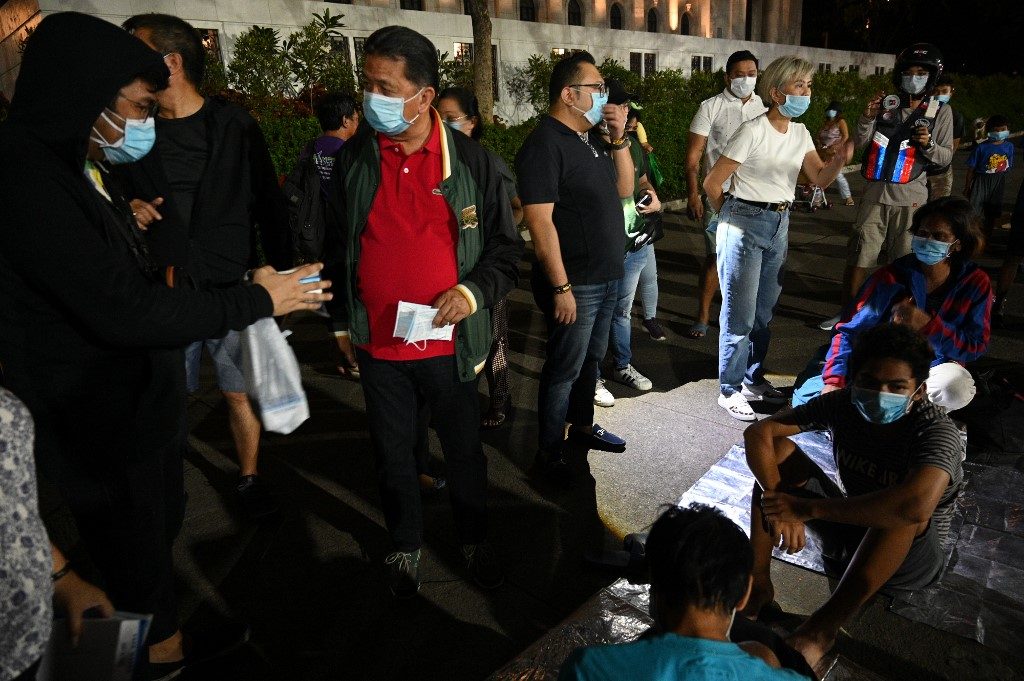SUMMARY
This is AI generated summarization, which may have errors. For context, always refer to the full article.

MANILA, Philippines – A scientist from the University of the Philippines (UP) said consumers in Metro Manila might have unnecessarily panicked over the need for N95 masks after the Taal Volcano in Batangas started to spew ash on Sunday, January 12.
Despite the ashfall that spread from Batangas to Calabarzon, the National Capital Region, the provinces of Tarlac and Nueva Ecija, and parts of Pangasinan and Zambales, the level of pollution in the NCR remained from considerably low to moderate.
On Sunday, state volcanologists raised the alert level for Taal Volcano from 1 to 4 within a day. Metro Manila residents started to experience some ashfall Sunday evening until Monday morning, January 13.
Metro Manila spared from much of the plume ash
However, University of the Philippines Institute of Environmental Science and Meteorology (UP IESM) professor Dr Gerry Bagtasa, a researcher specializing in air quality, said that, while Metro Manila residents experienced some ashfall, much of the ash from the plumes caused by the volcanic activity did not descend to the surface.
“Ayon sa isang equipment ng University of Wisconsin sa Quezon City, hindi in fact bumaba ang karamihan ng plume ash papuntang surface. Bumaba siya up to 3 km, pero nag-stop siya roon. Mayroon pa rin namang ash, pero dito sa ibaba, wala gaano,” Bagtasa said.
(According to one equipment of the University of Wisconsin in Quezon City, much of the plume ash did not descend to the surface. It went down to up to 3 kilometers, but it stopped there. We still experienced ashfall and we’ve seen ash here, but not that much.)
He added that the ash seen covering vehicles in Metro Manila were too large to be inhaled.
Air quality in Metro Manila still ‘good’
At the same time, Bagtasa explained that many air quality sensors, at least in Quezon City, recorded low levels of air pollution, despite many Metro Manila residents seeing ash and dust covering vehicles on Monday morning.
“Itong mga specks of ashes na nasa ibabaw ng sasakyan, range around 50-170 μm (micrometers). For context lang, ang width ng buhok, ang kapal ng buhok, is 50 μm. So ‘yung nakita natin kanina na visible sa mata, ‘yung kapal niya, ‘yung diameter niya is around the width of the hair or around 3 times larger than the width of the hair. Ito ay malalaki. In fact, hindi natin siya nahihinga paloob ng katawan natin,” Bagtasa said.
(These tiny specks of ash on top of vehicles range from 50 to 170 μm. The width of hair is about 50 μm. What we saw earlier, which was visible to the naked eye, have diameters that are about the width of the hair or up to around 3 times the width of a hair strand. That’s big. In fact, we cannot inhale them.)
“Kaunti lang naman ang pollution galing from the volcano. Most of the pollutants from yesterday ay doon pa rin sa typical na mga sasakyan kahit na Linggo,” he said.
(The volcanic activity has little impact on Metro Manila’s air pollution [on Sunday evening]. Most of the pollutants from yesterday came from the typical vehicle emission even if it was a Sunday.)
Misplaced panic buying of N95 masks
Bagtasa also said that because Metro Manila residents felt much of the ashfall, people went overboard with panic buying N95 masks.
According to World Health Organization (WHO) standards, humans can be exposed to pollutants of up to 25 μg/m3 (micrograms per cubic meter). On Sunday night, particulate matter or pollutants went up to 60 μg/m3. This could be considered as “moderate.”
“‘Pag sinabing moderate, hindi naman lahat ng tao magkakasakit or mauubo. So ‘yung mga vulnerable na tao – mga bata, matatanda, mga may sakit sa lungs, may asthma – sila ang unang makakaramdam nitong air pollution na ito. Sila, kailangan nila noong mask na iyon, even at relatively low levels, so moderate levels,” Bagtasa said.
(When we say moderate, not everyone will fall sick. Only those considered vulnerable – the children, the elderly, and those who have pre-existing respiratory conditions, like asthma – need to wear N95 masks.)
He added: “For most of the population, it’s not necessary. This morning, bumaba na siya (it went down) to about 9-10 μg/m3 until this (Monday) afternoon, so that is definitely lower than 25. In fact, our air quality is good today.” – Rappler.com
Add a comment
How does this make you feel?
There are no comments yet. Add your comment to start the conversation.